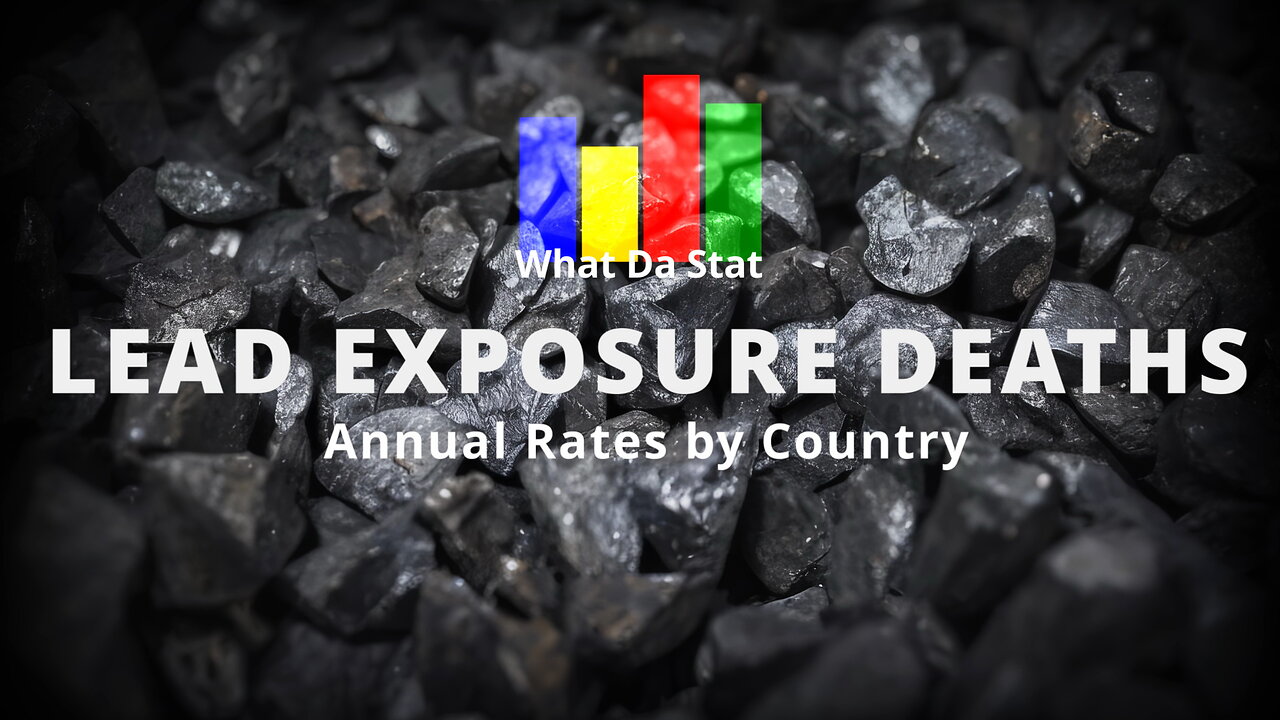Premium Only Content

Deaths Rates from LEAD Exposure by Country and World
This bar chart race shows the annual death rates from lead exposure by country and world, from 1990 to 2019, per 100,000.
Lead, a highly toxic heavy metal, has been used in various industrial and household applications for centuries, but its adverse health effects have only come to light in recent decades. Tragically, exposure to lead continues to claim lives, affecting populations across the globe, irrespective of geographical boundaries.
Causes of Lead Exposure:
Lead exposure primarily occurs through ingestion, inhalation, or skin contact with lead-based products or contaminated substances. Some common causes of lead exposure include:
Paint and Dust: In the past, lead-based paint was widely used, and older buildings still contain layers of lead paint that can deteriorate over time, releasing lead dust into the air. Children living in such environments are particularly vulnerable to lead poisoning when they inhale or ingest this dust during play.
Drinking Water: Lead can leach into drinking water from old plumbing systems, lead pipes, or fixtures made with lead solder. Prolonged consumption of contaminated water can lead to severe health consequences.
Occupational Exposure: Workers in industries like mining, battery manufacturing, and recycling are at risk of lead exposure due to their proximity to lead-containing materials or processes.
Soil Contamination: Lead particles from industrial activities, emissions, or leaded gasoline can contaminate soil. This contamination can pose a threat, especially in urban areas or near industrial sites.
Geographical Distribution:
Lead exposure is not limited to a specific region but can be found across the globe. However, the prevalence and severity of lead poisoning vary based on socio-economic factors, industrialization, and regulation. Some regions are disproportionately affected:
Developing Nations: Many low and middle-income countries lack stringent regulations on lead usage and disposal, leading to higher exposure levels. Inadequate healthcare facilities may also contribute to higher mortality rates in affected areas.
Industrial Hubs: Regions with a history of heavy industries, such as mining, smelting, and manufacturing, may have elevated lead levels in their environment, impacting the health of local residents.
Urban Centers: In densely populated urban areas, aging infrastructure and buildings with lead-based paint can exacerbate the risk of exposure, especially for children living in poorly-maintained housing.
Impact on Health:
Lead exposure can have severe consequences for human health. Children and pregnant women are particularly vulnerable, as lead can hinder cognitive development, cause learning disabilities, and impair neurological functions. Adults can experience cardiovascular issues, kidney damage, and reproductive problems due to lead exposure. In extreme cases, lead poisoning can be fatal.
Prevention and Awareness:
Addressing deaths caused by lead exposure requires a multi-faceted approach:
Regulation: Governments must enforce strict regulations on lead usage in industries, paints, and products. Additionally, monitoring water quality and addressing lead contamination in old infrastructure is crucial.
Public Awareness: Raising awareness about lead exposure, its sources, and preventive measures is vital in empowering communities to protect themselves.
Remediation: Remediation efforts should focus on cleaning up lead-contaminated sites and promoting lead-safe practices in construction and renovation projects.
Health Interventions: Timely medical interventions, such as chelation therapy for severe cases of lead poisoning, can save lives and reduce long-term health impacts.
In conclusion, the tragic deaths caused by lead exposure remain a pressing global issue. The indiscriminate nature of this toxic metal demands collective efforts from governments, industries, healthcare professionals, and communities alike to mitigate its deadly effects. By prioritizing prevention, regulation, and education, we can hope for a future where lead exposure becomes a distant memory, sparing countless lives from its toxic grip.
Source: Global Burden of Disease Collaborative Network. Global Burden of Disease Study 2019 (GBD 2019) Results. Seattle, United States: Institute for Health Metrics and Evaluation (IHME), 2021.
Music: Darren Curtis - Predator or Prey
https://soundcloud.com/desperate-measurez/dark-chimes-and-vocals-predator-or-prey-royalty-free-horror-theme
Data visualization created with flourish.studio and AI
-
 1:10:29
1:10:29
Chad Prather
14 hours agoStanding Holy in a Hostile World
44.9K27 -
 LIVE
LIVE
LFA TV
13 hours agoLIVE & BREAKING NEWS! | FRIDAY 10/31/25
2,471 watching -
 1:04:43
1:04:43
Crypto Power Hour
13 hours ago $9.86 earnedCrypto Price Swings Explained — What Every Investor Needs to Know
45.9K7 -
 21:31
21:31
Clownfish TV
23 hours agoOG YouTube is Officially ENDING! Employees Offered BUYOUTS?! | Clownfish TV
21.6K32 -
 5:54
5:54
Gun Owners Of America
20 hours agoThe Virginia Election Could Shift The Balance of Power Nationwide
29.9K5 -
 2:00:02
2:00:02
BEK TV
1 day agoTrent Loos in the Morning - 10/31/2025
22.6K2 -
 4:05:45
4:05:45
The Bubba Army
1 day agoIs Killing The New Trend??! - Bubba the Love Sponge® Show | 10/31/25
63.6K2 -
 2:25:16
2:25:16
Demons Row
15 hours ago $7.29 earnedEx Hells Angels MC President: Charles “Peewee”Goldsmith (Full Interview)
29.2K5 -
 3:35
3:35
Gamazda
13 hours ago $7.76 earnedThe Darkest Piano Theme?
38.6K41 -
 13:42
13:42
Nate The Lawyer
22 hours ago $6.25 earnedINSANE Judge REMOVED For Lying Under Oath, Insurance Fraud & Stolen Valor
29.9K17